I believe composition instructors must alter traditional
attitudes about composition. What are the real-world roles we play in
written communication? How do our curriculums reflect what's going on
in today's world? Dissemination of information must be reader friendly,
and that means visually stimulating, intelligent writing. We can no longer
ignore the visual form; it brings added power to the symbols themselves,
creating a message with a deeper scope and value in our mainstream society.
In my own teaching experiences I have seen first hand how attitudes
must change in order to solicit the right kind of fusion between academic
writing and current marketplace practices. There was a striking
difference between my attitude about writing in my freshman composition
class ten years ago and my attitude about it in the technical writing
course I took last year. As a freshman, I struggled to find a topic for
which I felt comfortable writing. I knew it had to be of academic quality,
and that only my instructor was going to read it outside of the two classmates
chosen to be in my peer editing group. The night before the paper was
due I knew I had less than the required amount of words, so I did what
most students at that age believe is necessary; I stretched what I had to
say into longer, clumsier, needless phrases. Years later I learned that
brevity is key. The purpose for writing is not to meet a length requirement;
it is to communicate ideas in a clear and concise manner. I learned this
because I had to write for the Web. It wasn’t practice; it wasn’t meaningless,
or without an audience. I had a voice, and it was going to be heard by someone
who would ultimately dictate to me whether or not my message was successful.
If principles of visual rhetoric are taught correctly, rather
than cheapen the academic essay, the electronic media enhances it,
broadens the scope and depth by which the information is presented and
disseminated; and if presented within a specially organized discourse
community of peers, this form of writing will succeed in fostering a passion
for the subject that surpasses the traditional written essay form.
But writing for the Web is only one aspect of visual literacy.
Reynolds reminds us that visual literacy incorporates a number of
forms that must be considered: online discussion groups, Blogs, MOOs,
Web sites, and emails. “Each can teach basic writing in exciting new
ways” (Reynolds 135). It is our job as an institution for literacy,
to sift through the various electronic forms available, experiment with
our various ideologies, come to terms with what works, what doesn’t,
what is harmful to our culture, what must be preserved. If we don’t do
this, if we ignore the barrage of information on the Web, how it is constructed
(or mis-constructed) for common readers, then who will? The wind is blowing—are
we going to bend or break?
|
